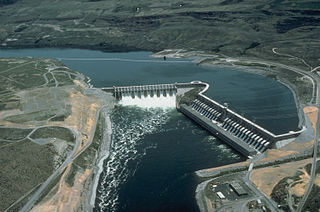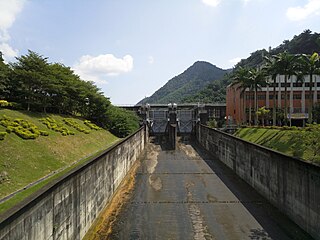
Hydropower, also known as water power, is the use of falling or fast-running water to produce electricity or to power machines. This is achieved by converting the gravitational potential or kinetic energy of a water source to produce power. Hydropower is a method of sustainable energy production. Hydropower is now used principally for hydroelectric power generation, and is also applied as one half of an energy storage system known as pumped-storage hydroelectricity.

Small hydro is the development of hydroelectric power on a scale suitable for local community and industry, or to contribute to distributed generation in a regional electricity grid. Exact definitions vary, but a "small hydro" project is less than 50 megawatts (MW), and can be further subdivide by scale into "mini" (<1MW), "micro" (<100 kW), "pico" (<10 kW). In contrast many hydroelectric projects are of enormous size, such as the generating plant at the Three Gorges Dam at 22,500 megawatts or the vast multiple projects of the Tennessee Valley Authority.

Hydroelectricity, or hydroelectric power, is electricity generated from hydropower. Hydropower supplies one sixth of the world's electricity, almost 4,500 TWh in 2020, which is more than all other renewable sources combined and also more than nuclear power. Hydropower can provide large amounts of low-carbon electricity on demand, making it a key element for creating secure and clean electricity supply systems. A hydroelectric power station that has a dam and reservoir is a flexible source, since the amount of electricity produced can be increased or decreased in seconds or minutes in response to varying electricity demand. Once a hydroelectric complex is constructed, it produces no direct waste, and almost always emits considerably less greenhouse gas than fossil fuel-powered energy plants. However, when constructed in lowland rainforest areas, where part of the forest is inundated, substantial amounts of greenhouse gases may be emitted.

The Bakun Dam is an embankment dam located in Belaga District, Kapit Division, Sarawak, Malaysia, on the Balui River, a tributary or source of the Rajang River and some sixty kilometres east of Belaga. As part of the project, the second tallest concrete-faced rockfill dam in the world would be built. It would generate 2,400 megawatts (MW) of electricity once completed.

National Grid, Malaysia is the high-voltage electric power transmission network in Peninsular Malaysia. It is operated and owned by Tenaga Nasional Berhad (TNB) by its Transmission Division. There are two other electrical grids in Sabah and Sarawak operated by Sabah Electricity Sdn Bhd (SESB) and Sarawak Energy Berhad (SEB) respectively.

The Robert Moses Niagara Hydroelectric Power Station is a hydroelectric power station in Lewiston, New York, near Niagara Falls. Owned and operated by the New York Power Authority (NYPA), the plant diverts water from the Niagara River above Niagara Falls and returns the water into the lower portion of the river near Lake Ontario. It uses 13 generators at an installed capacity of 2,525 MW (3,386,000 hp) with an average annual net generation of 15,897,000 MWh between 2014 and 2023, and a capacity factor of 71.9%.
Sultan Mahmud Power Station or Kenyir Dam is the hydroelectric dam which forms Kenyir Lake, Terengganu, Malaysia. It is located 50 km southwest of Kuala Terengganu on the Kenyir River. The project is a multipurpose hydroelectric power and flood mitigation scheme.

Run-of-river hydroelectricity (ROR) or run-of-the-river hydroelectricity is a type of hydroelectric generation plant whereby little or no water storage is provided. Run-of-the-river power plants may have no water storage at all or a limited amount of storage, in which case the storage reservoir is referred to as pondage. A plant without pondage is subject to seasonal river flows, so the plant will operate as an intermittent energy source. Conventional hydro uses reservoirs, which regulate water for flood control, dispatchable electrical power, and the provision of fresh water for agriculture.
According to the International Hydropower Association, Canada is the fourth largest producer of hydroelectricity in the world in 2021 after the United States, Brazil, and China. In 2019, Canada produced 632.2 TWh of electricity with 60% of energy coming from Hydroelectric and Tidal Energy Sources).

The Murum Dam is a gravity dam on the Murum River in Sarawak, Malaysia. Construction began in 2008, the dam's reservoir began to fill in July 2013 and the first generator was commissioned in December 2014. The fourth and final turbine became operational on 8 June 2015. Concerns have been raised about the displacement of the Dayak people and the removal of rainforest due to the construction of the dam.

The John C. Boyle Dam is a hydroelectric dam located in southern Oregon, United States. It is on the upper Klamath River, south (downstream) of Keno, and about 12 miles (19 km) north of the California border. Originally developed and known as Big Bend, the John C. Boyle dam and powerhouse complex was re-dedicated to honor the pioneer hydroelectric engineer who was responsible for the design of virtually all of the Klamath Hydroelectric Project.

The Gilgel Gibe III Dam is a 250m high roller-compacted concrete dam with an associated hydroelectric power plant on the Omo River in Ethiopia. It is located about 62 km (39 mi) west of Sodo in the Southern Nations, Nationalities, and Peoples' Region. Once fully commissioned, it will be the third largest hydroelectric plant in Africa with a power output of about 1,870 Megawatt (MW), thus more than doubling total installed capacity in Ethiopia from its 2007 level of 814 MW. The Gibe III dam is part of the Gibe cascade, a series of dams including the existing Gibe I dam and Gibe II power station as well as the planned Gibe IV and Gibe V dams. The existing dams are owned and operated by the state-owned Ethiopian Electric Power, which is also the client for the Gibe III Dam.

The Kannagawa Hydropower Plant (神流川発電所) is an under construction pumped-storage hydroelectric power plant near Minamiaiki in Nagano Prefecture and Ueno in Gunma Prefecture, Japan. The power plant utilizes the Minamiaiki River along with an upper and lower reservoir created by two dams, the upper Minamiaiki Dam and the lower Ueno Dam. The power station in between the two dams will contain six 470 megawatts (630,000 hp) pump-generators for a total installed capacity of 2,820 megawatts (3,780,000 hp). Unit 1 commenced commercial operation in 2005 and Unit 2 in 2012. When completed, the plant will have the third-largest pumped-storage power capacity in the world.

The Zimapán Dam, also known as Fernando Hiriart Balderrama Dam, is an arch dam on the Moctezuma River about 15 km (9 mi) southwest of Zimapán in Hidalgo state, Mexico. The primary purpose of the dam is hydroelectric power production and it services a 292 MW power station with water.

The Minghu Dam (Chinese: 明湖水壩; pinyin: Mínghú Shuǐbà, renamed the Takuan Dam, is a concrete gravity dam on the Shuili River located 7 km north of Shuili Township in Nantou County, Taiwan. The reservoir formed by the dam serves as the lower reservoir for the Minhu Pumped Storage Hydro Power Station. Sun Moon Lake serves as the upper reservoir.
Garzan Dam is an embankment dam on the Garzan River 9 km (5.6 mi) northeast of Kozluk in Batman Province, Turkey. It is part of the Southeastern Anatolia Project and has a primary purpose of hydroelectric power generation and irrigation. Surveys for the dam were completed in 2008, construction began in 2009 and the dam began to impound its reservoir in October 2012. The power plant has an installed capacity of 49 MW. The irrigation works remain under construction and are expected to irrigate an area of 40,000 ha when complete. The dam was awarded to FERNAS Energy Electricity Generation Co. Inc. in 2011 under a build–operate–transfer basis.
The Bowatenna Dam is a 100 ft (30 m) high gravity dam at Bowatenna, in Central Province of Sri Lanka. The dam was built in June 1981, and is used primarily for irrigation. A 40 MW power station is also constructed 5,800 ft (1,800 m) downstream, for hydroelectric power generation.

The Kulekhani Dam is a rock-fill dam on the Kulekhani River near Kulekhani in the Indrasarowar Rural Municipality of Makwanpur District in Bagmati Province, Nepal. The primary purpose of the dam is hydroelectric power generation and it supports the 60 MW Kulekhani I, 32 MW Kulekhani II and 14 MW Kulekhani III Hydropower Stations. Construction began in 1977 and Kulekhani I was commissioned in 1982. Kulekhani II was commissioned in 1986 and a third power station, the 14 MW Kulekhani III was expected to be commissioned in May 2015 but was delayed due to issues with the builder. The US$117.84 million project received funding from the World Bank, Kuwait Fund, UNDP, Overseas Economic Cooperation Fund and OPEC Fund. It is owned by Nepal Electricity Authority.
The Ulu Jelai Power Station is a hydroelectric power station located in the district of Cameron Highlands, Pahang, Malaysia. It is one of the entry point projects under the Economic Transformation Programme.














